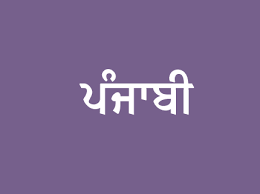Difference between revisions of "Language/Panjabi/Grammar/Conjunctions"
m (Quick edit) |
m (Quick edit) |
||
| Line 1: | Line 1: | ||
<span pgnav> | |||
{| class="wikitable pg_template_nav" | |||
|[[Language/Panjabi/Grammar/Prepositions|◀️ Prepositions — Previous Lesson]] | |||
|[[Language/Panjabi/Culture/Folklore-and-Legends|Next Lesson — Folklore and Legends ▶️]] | |||
|} | |||
</span> | |||
{{Panjabi-Page-Top}} | {{Panjabi-Page-Top}} | ||
| Line 134: | Line 141: | ||
{{Panjabi-Page-Bottom}} | {{Panjabi-Page-Bottom}} | ||
<span links></span> | <span links></span> | ||
<span pgnav> | |||
{| class="wikitable pg_template_nav" | |||
|[[Language/Panjabi/Grammar/Prepositions|◀️ Prepositions — Previous Lesson]] | |||
|[[Language/Panjabi/Culture/Folklore-and-Legends|Next Lesson — Folklore and Legends ▶️]] | |||
|} | |||
</span> | |||
Revision as of 19:33, 29 March 2023
| ◀️ Prepositions — Previous Lesson | Next Lesson — Folklore and Legends ▶️ |
As we progress in learning Panjabi grammar, we come across many different types of words and phrases that help us to create meaningful sentences. One such type of words is conjunctions. In this lesson, we will learn how to use conjunctions to connect words, phrases, and clauses in Panjabi.
Take a moment to explore these relevant pages as you conclude this lesson: 0 to A1 Course & Conditional Mood.
What are Conjunctions?
Conjunctions are words used to connect two or more words, phrases, or clauses. They are used to show how the different parts of a sentence are related to each other. Conjunctions can be used to make complex sentences by joining two or more simple sentences.
For example, consider the following sentences:
- He wakes up early.
- He goes for a jog.
These two sentences can be joined together using a conjunction to form a complex sentence:
"He wakes up early and goes for a jog."
In this sentence, the conjunction "and" is used to join the two simple sentences.
Types of Conjunctions
In Panjabi, there are two types of conjunctions:
- Coordinating Conjunctions
- Subordinating Conjunctions
Coordinating Conjunctions
Coordinating conjunctions are used to link two or more words, phrases, or clauses of equal importance. The most common coordinating conjunctions in Panjabi are:
- ਅਤੇ (ate) - and
- ਤੇ (te) - and
- ਪਰ (par) - but
- ਜਾਂ (jan) - or
- ਅਕਸਰ (aksar) - often
Here are some examples of how to use coordinating conjunctions:
| Panjabi | Pronunciation | English |
|---|---|---|
| ਮੈਂ ਸੋ ਰਿਹਾ ਹਾਂ ਅਤੇ ਮੇਰੇ ਸਖ਼ਤ ਵਿਰਸੇ ਹਨ। | Main so rihā hāṃ ate mere sakhata virase han. | I am sleeping and my muscles are sore. |
| ਉਹ ਅਜਿਹਾ ਹੈ ਜਿਸਦਾ ਕਿਸੇ ਤੇ ਬਹੁਤ ਭਰੋਸਾ ਨਹੀਂ ਹੈ। ਪਰ ਮੈਂ ਉਸਨੇ ਇਸ ਕਾਰਨ ਨਹੀਂ ਛੱਡਿਆ। | Uh ajihā hai jisadā kise te bahuta bharosā nahīṃ hai. Par main usanē is kārana nahīṃ chhaḍī'ā. | He is such a person on whom nobody trusts. But I haven't left him because of it. |
Subordinating Conjunctions
Subordinating conjunctions are used to link two clauses of unequal importance. One clause is the main clause and the other is a subordinate clause. Subordinating conjunctions are used to indicate the relationship between the main and the subordinate clause. The most common subordinating conjunctions in Panjabi are:
- ਕਿ (ki) – that/which/who
- ਜਦੋਂ (jadoṃ) – when
- ਜਿਹਾ (jiha) – which/that
- ਜਿਵੇਂ (jivēṃ) – as/like
- ਸ਼ਾਇਦ (sha'id) – may be/ perhaps
Here are some examples of how to use subordinating conjunctions:
| Panjabi | Pronunciation | English |
|---|---|---|
| ਮੈਂ ਜਾਣਦਾ ਹਾਂ ਕਿ ਤੁਸੀਂ ਸੋ ਰਹੇ ਹੋ। | Main jāṇadā hāṃ ki tusī so rahe ho. | I know that you are sleeping. |
| ਜਦੋਂ ਤੁਸੀਂ ਮੇਰੇ ਘਰ ਆਓਗੇ, ਮੈਂ ਤੁਹਾਨੂੰ ਪਕਾਣ ਲਈ ਹੁਣ ਹੀ ਤਿਆਰ ਕਰ ਦੇਵਾਂਗਾ। | Jadoṃ tusī mere ghara ā'ogē, main tuhānū pakāṇa la'ī huṇ hī ti'āra kar dēvāṅgā. | When you come to my house, I will prepare food for you. |
Conclusion
Conjunctions are an essential part of Panjabi grammar as they allow us to combine words, phrases, and clauses to create meaningful sentences. Coordinating conjunctions link two or more equal clauses, while subordinating conjunctions link two unequal clauses. By using conjunctions effectively, we can make our Panjabi sentences more complex and meaningful.
Remember to practice using conjunctions in your Panjabi conversations and writing. With time and practice, you will be able to use conjunctions with ease and make your sentences more expressive and impressive.
Great work on completing this lesson! Take a moment to investigate these connected pages: Negation & Past Tense.
Other Lessons
- Gurmukhi Alphabet
- Past Tense
- Asking Questions
- Adjectives and Adverbs
- Nouns
- Future Tense
- Questions
- Give your Opinion
- How to Use Be
| ◀️ Prepositions — Previous Lesson | Next Lesson — Folklore and Legends ▶️ |
